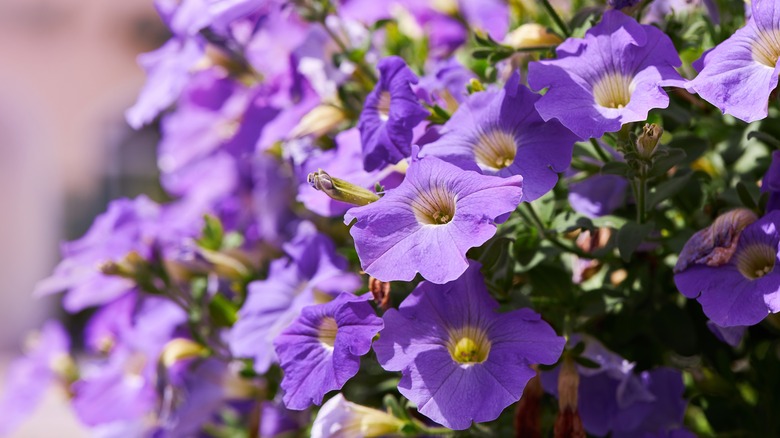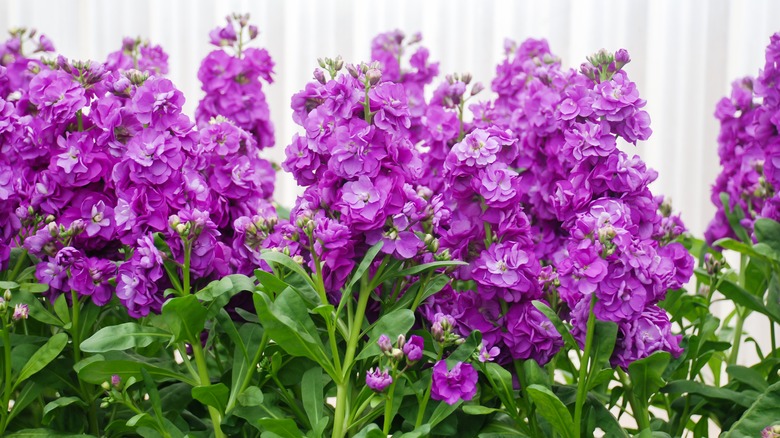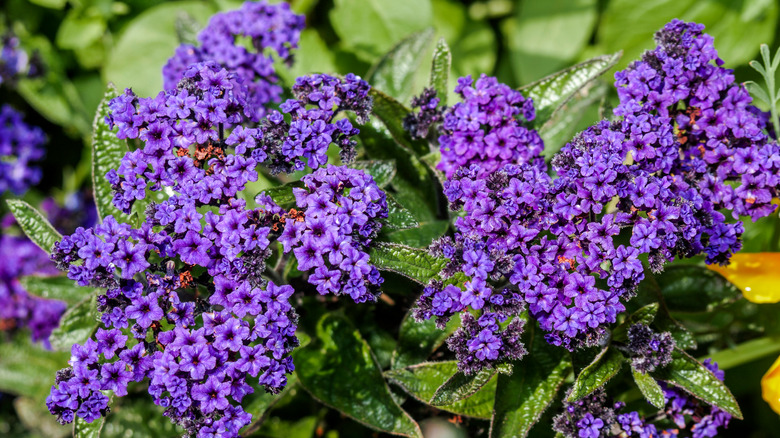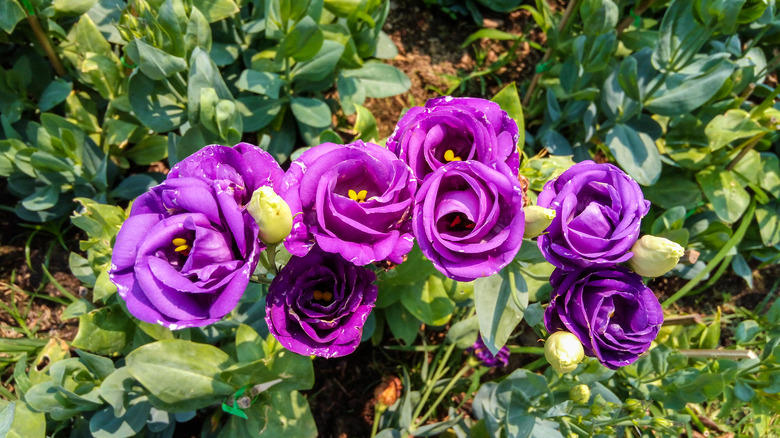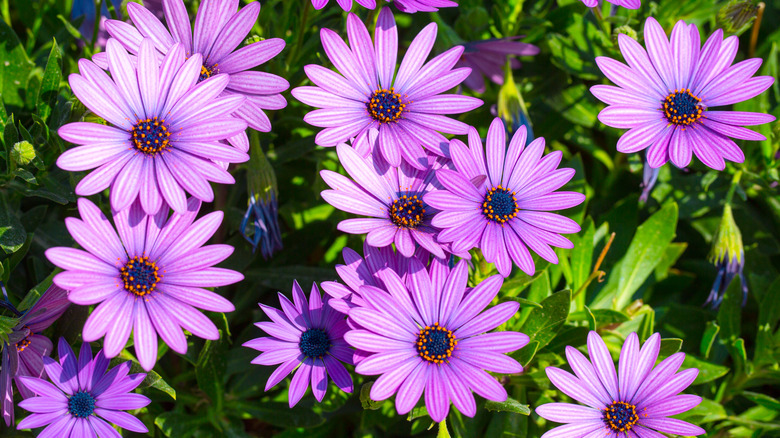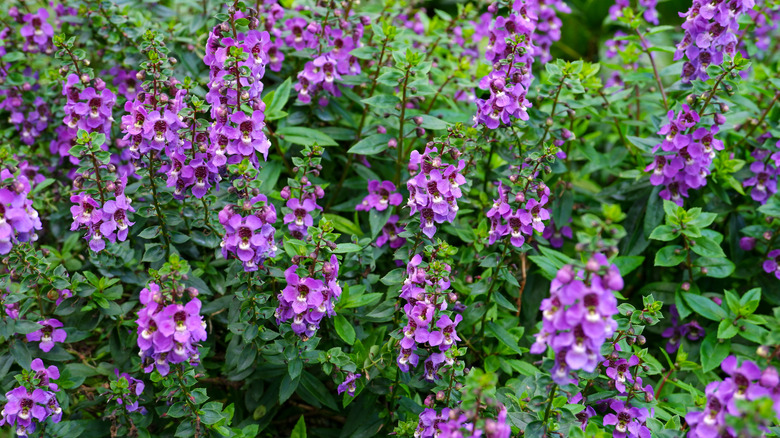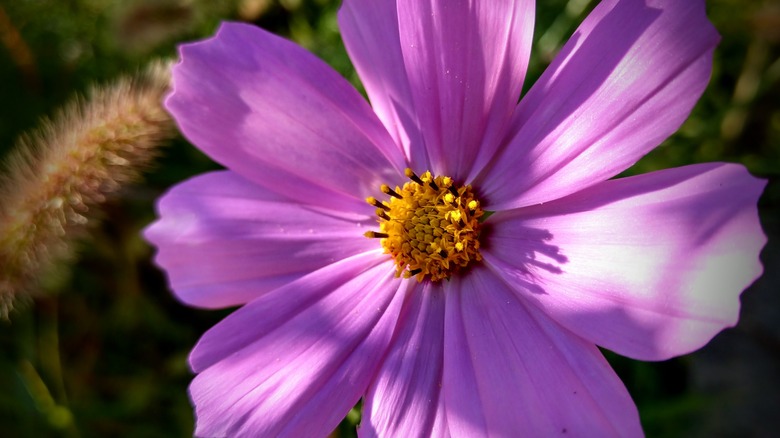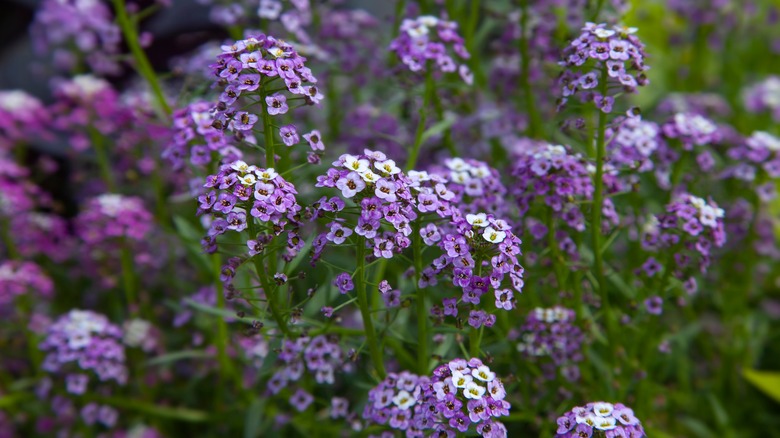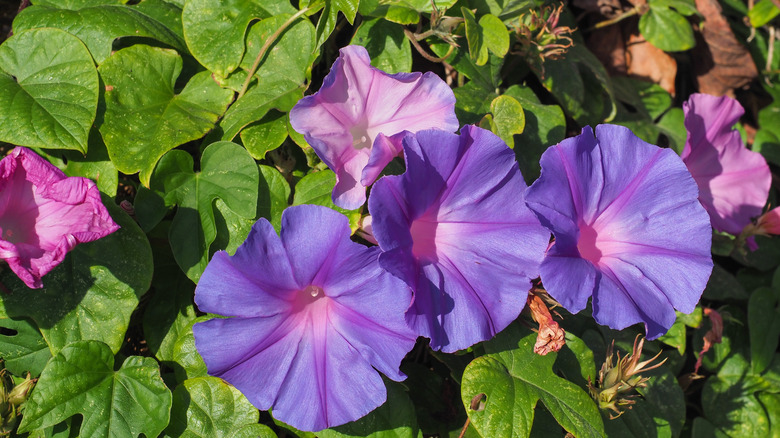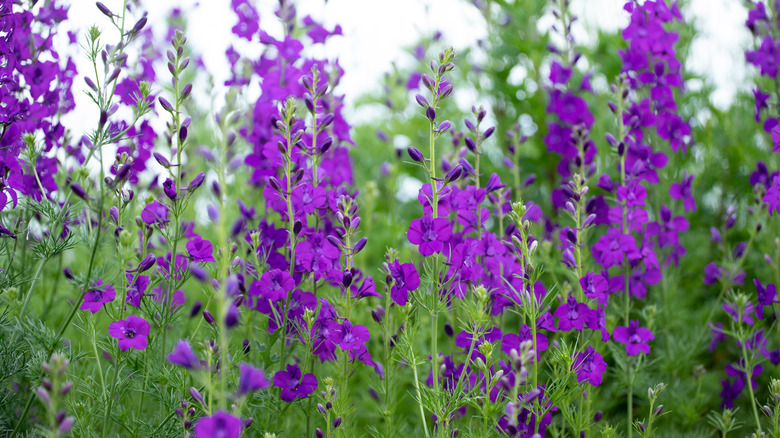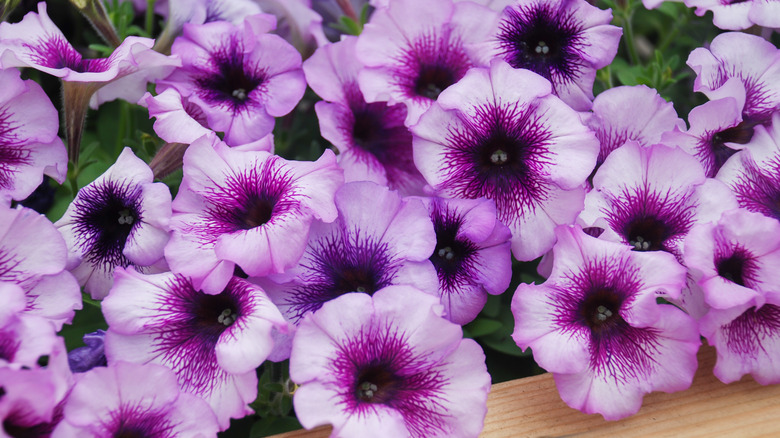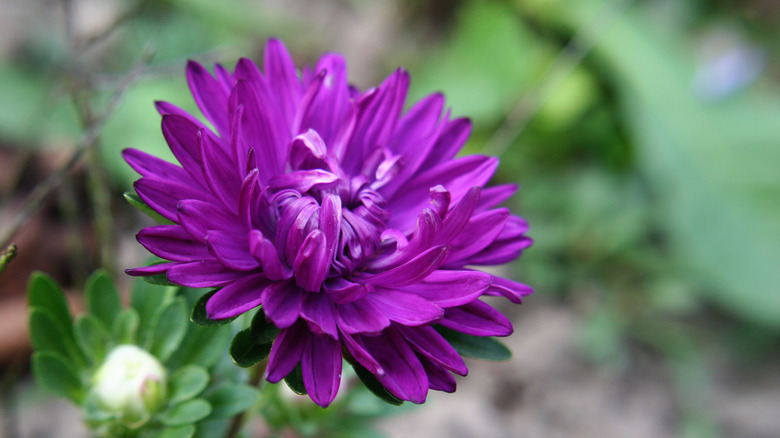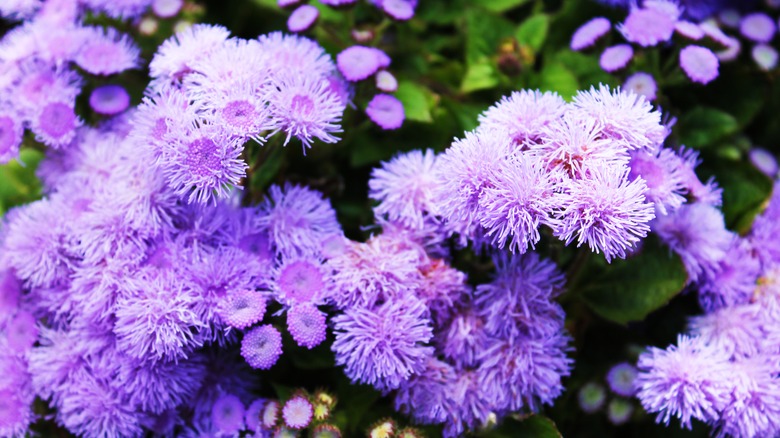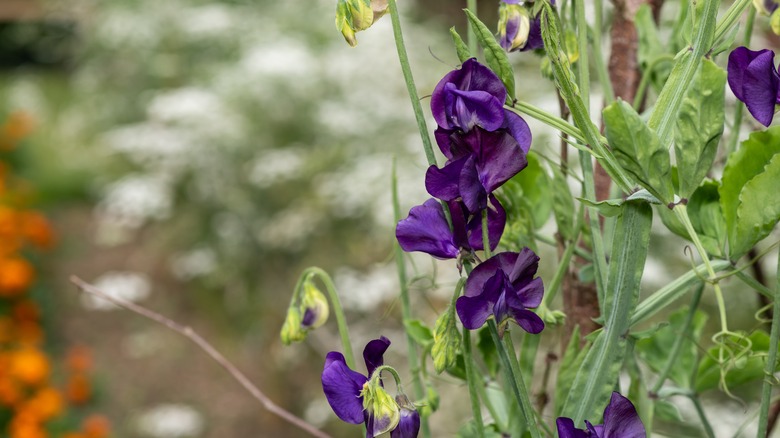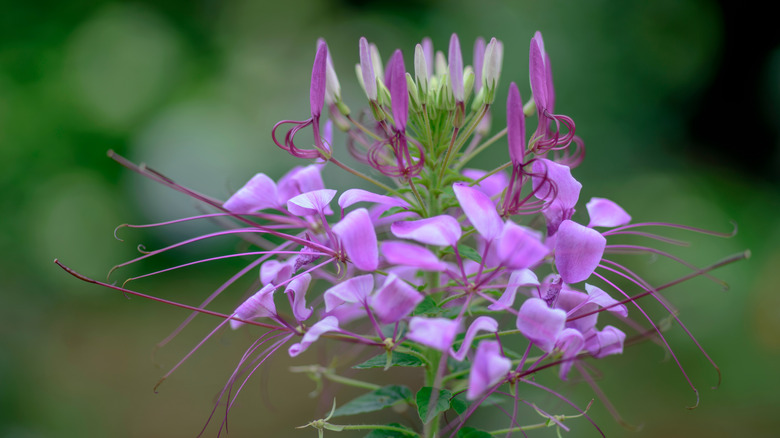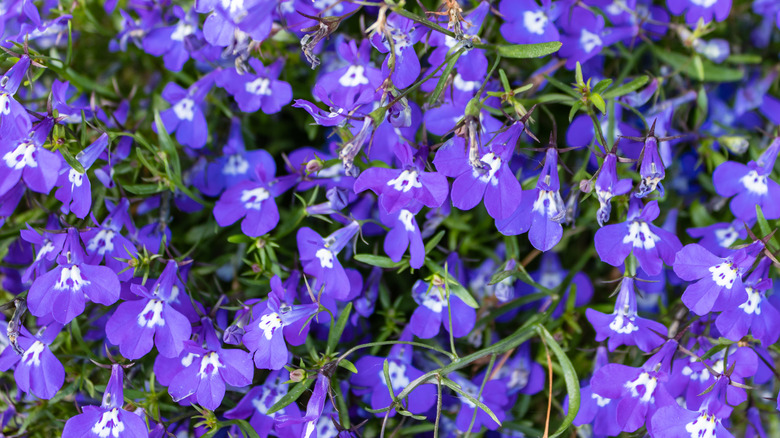15 Annuals That Bloom With Bold Purple Flowers
Purple flowers can be somewhat difficult to come by, depending on where you live. However, more often than not, when you are designing your garden, you are bombarded with flowers such as white daisies, yellow begonias, and pink geraniums. While these are beautiful without a doubt, sometimes you need some more of a moody color to make your garden stand out. Bold, purple blooms are a great way to achieve this look.
Keep in mind that annual flowers only live for a year or less. Normally, you can plant them in the spring after the last frost and watch them bloom throughout the summer and sometimes into the fall. Once they die, they may self-seed to grow again next spring, or they will need to be replanted. As taught by Miracle-Gro, this is the opposite of perennial flowers that grow year after year, even sticking around during the winter. So, when you're strictly looking for beautiful, bright, and eye-catching blossoms for the warmer months, try out some of the following flowers in this collection.
1. Stock
In most states, stock (Matthiola incana) is grown as a cool weather annual. It can be identified from its bright, usually purple flowers that smell like cloves, as described by Missouri Botanical Garden. You may also find stock blooming in pink, yellow, red, or white. They tend to flower into the fall, but hot summers can make them grow woody and stop blooming.
Bloom Season: Spring to fall
USDA Growing Zone: 7 to 10
Growing Conditions: Full sun
Soil Type: Well-draining
Size: 1 to 3 feet tall and 9 to 18 inches wide
2. Heliotrope
Heliotrope (Heliotropium arborescens), or Peruvian heliotrope, is a blooming shrub that boasts vanilla-scented purple blooms from summer to fall. The plant is a vigorous grower, reaching heights of about 6 feet in its natural environment. However, in cooler climates, it normally stays just below 2 feet tall, according to North Carolina State Extension.
Bloom Season: Summer and fall
USDA Growing Zone: 10 to 11
Growing Conditions: Full sun to partial shade
Soil Type: Well-draining
Size: Typically 12 to 18 inches tall and wide
3. Texas bluebell
Texas bluebells (Eustoma grandiflorum) have a few other names, including prairie gentian, bluebell gentian, and lisianthus. Native to the great plains region of the United States, this flower grows best in average garden soil that is also well-draining, as per Missouri Botanical Garden. When cared for properly, the Texas bluebell produces large purple and white flowers that last until the fall.
Bloom Season: Summer to fall
USDA Growing Zone: 8 to 10
Growing Conditions: Full sun
Soil Type: Moist and well-draining
Size: 1 to 3 feet tall and 9 to 12 inches tall
4. African daisy
African daisies (Osteospermum spp.) are commonly grown in garden beds across America. The plant's delightful flowers bloom in a range of colors, but the best is a lavender color that will brighten any plot of land. As told by RHS, these species typically have gray-green leaves.
Bloom Season: Summer to fall
USDA Growing Zone: 10 to 11
Growing Conditions: Full sun
Soil Type: Well-draining sand, loam, or clay
Size: 4 to 20 inches tall and 20 to 40 inches wide
5. Summer snapdragon
Summer snapdragons (Angelonia spp.) are known for their large blooming stalks that fill with flowers during their long-bloom period. Even though they are a heat-loving species, they do well in gardens in most climates, as noted by Proven Winners. However, if your home experiences cold winters, expect the need to replant yours in the spring.
Bloom Season: Spring to fall
USDA Growing Zone: 10 to 11
Growing Conditions: Full sun
Soil Type: Well-draining
Size: 18 to 30 inches tall and 12 to 18 inches wide
6. Mexican aster
The Mexican aster (Cosmos bipinnatus) is an extremely popular plant that you are likely already familiar with. It is a sprawling annual that shows off its petals in a wide range of colors, as explained by Washington State University. When grown properly, your Mexican asters can reach up to 4 feet tall, which makes them great for the back or middle of a border garden.
Bloom Season: Summer to fall
USDA Growing Zone: 5 to 9
Growing Conditions: Full sun
Soil Type: Well-draining
Size: 4 feet tall and 3 feet wide
7. Sweet alyssum
Sweet alyssum (Lobularia maritima) is often grown for its clusters of delicate blooms that smell like honey. These are attractive to pollinators such as bees, hummingbirds, and butterflies, which makes them a beneficial option for your garden. In addition, as mentioned by the University of Wisconsin-Madison, sweet alyssum makes for a good bedding plant because it is mat-forming and spreads widely.
Bloom Season: Spring to fall or year-round in warmer regions
USDA Growing Zone: 5 to 9
Growing Conditions: Full sun to partial shade
Soil Type: Well-draining
Size: 3 to 9 inches tall
8. Morning glory
Morning glory (Ipomoea indica) is a vining plant that is most often grown on a fence, trellis, or building where it uses its aerial roots to grab hold of a structure and climb upward. In the right conditions, this purple-blooming flower can reach up to 15 feet tall, as noted by San Marcos Growers.
Bloom Season: Spring to fall
USDA Growing Zone: 8 to 11
Growing Conditions: Full sun
Soil Type: Loamy and well-draining
Size: 4 to 15 feet tall and 2 to 3 feet wide
9. Giant larkspur
Giant larkspurs (Consolida ajacis) are well-known for their relatively tall growth habit and profusely blooming flower stalks that can appear purple, blue, pink, red, or white depending on the cultivar, says Missouri Botanical Garden. Though giant larkspur is considered an annual, it is known to reseed so you can enjoy its lovely blossoms each summer.
Bloom Season: Summer
USDA Growing Zone: 2 to 11
Growing Conditions: Full sun
Soil Type: Loose, rich, evenly moist, and well-draining
Size: 2 to 4 feet tall and 12 to 18 inches wide
10. Petunia
Petunias (Petunia spp.) are among the most popular annuals grown in the United States today. They are loved for their wide array of bloom colors, long flowering season, and minimal care requirements. As said by the University of Minnesota Extension, you should plant petunias in the spring just after the last frost date in your area.
Bloom Season: Spring to early winter
USDA Growing Zone: 10 to 11
Growing Conditions: Full sun
Soil Type: Well-draining
Size: 6 to 15 inches tall, depending on the cultivar
11. China aster
The China aster (Callistephus chinensis) is known for its resemblance to chrysanthemums. They feature large flowers that can measure up to 5 inches in diameter and bloom in shades of pink, purple, red, and yellow, mentions RHS. Also called the annual aster, this plant is only of interest in the summer and fall.
Bloom Season: Summer to fall
USDA Growing Zone: 2 to 11
Growing Conditions: Full sun
Soil Type: Evenly moist and well-draining
Size: 20 to 40 inches tall and 4 to 20 inches wide
12. Floss flower
Native to the warmer regions of South and Central America, floss flowers (Ageratum houstonianum) are grown as annuals in most parts of the United States. The Ageratum genus hosts just 43 species but the Ageratum houstonianum flower is the variety most often cultivated in the garden, according to the University of Wisconsin-Madison.
Bloom Season: Late spring to late fall
USDA Growing Zone: 2 to 11
Growing Conditions: Full sun
Soil Type: Moist and well-draining
Size: 6 to 30 inches tall, depending on the cultivar
13. Sweet pea
Sweet peas (Lathyrus odoratus) are a climbing annual typically grown on fences and trellises near paths that are used often. This is because the dainty flowers of the plant are scented like orange mixed with honey, and they are highly ornamental, as per RHS.
Bloom Season: Summer and fall
USDA Growing Zone: 2 to 11
Growing Conditions: Full sun to partial shade
Soil Type: Fertile and well-draining
Size: 5 to 8 feet tall
14. Spider flower
The spider flower (Cleome hassleriana) has a frightening name, but don't fret. The petals of this unique plant are what actually give it its name: Each flower features about six thin stamens that stretch out 3 inches long, as told by the University of Wisconsin-Madison. These stamens look similar to spider legs, hence the plant's name.
Bloom Season: Summer to fall
USDA Growing Zone: 10 to 11
Growing Conditions: Full sun
Soil Type: Evenly moist and well-draining
Size: 1 to 5 feet tall
15. Trailing lobelia
Trailing lobelia (Lobelia erinus) is yet another vining plant that blooms profusely with two-lipped, tubular blossoms. Most often, you will see this lobelia cultivar flower with blue-purple color, but it can also be found in pink, red, or yellow, states Missouri Botanical Garden. When growing this herbaceous plant, be sure to provide it with rich soil and plenty of moisture.
Bloom Season: Spring and summer
USDA Growing Zone: 10 to 11
Growing Conditions: Full sun to part shade
Soil Type: Well-draining and organically rich
Size: 6 to 9 inches tall and wide
